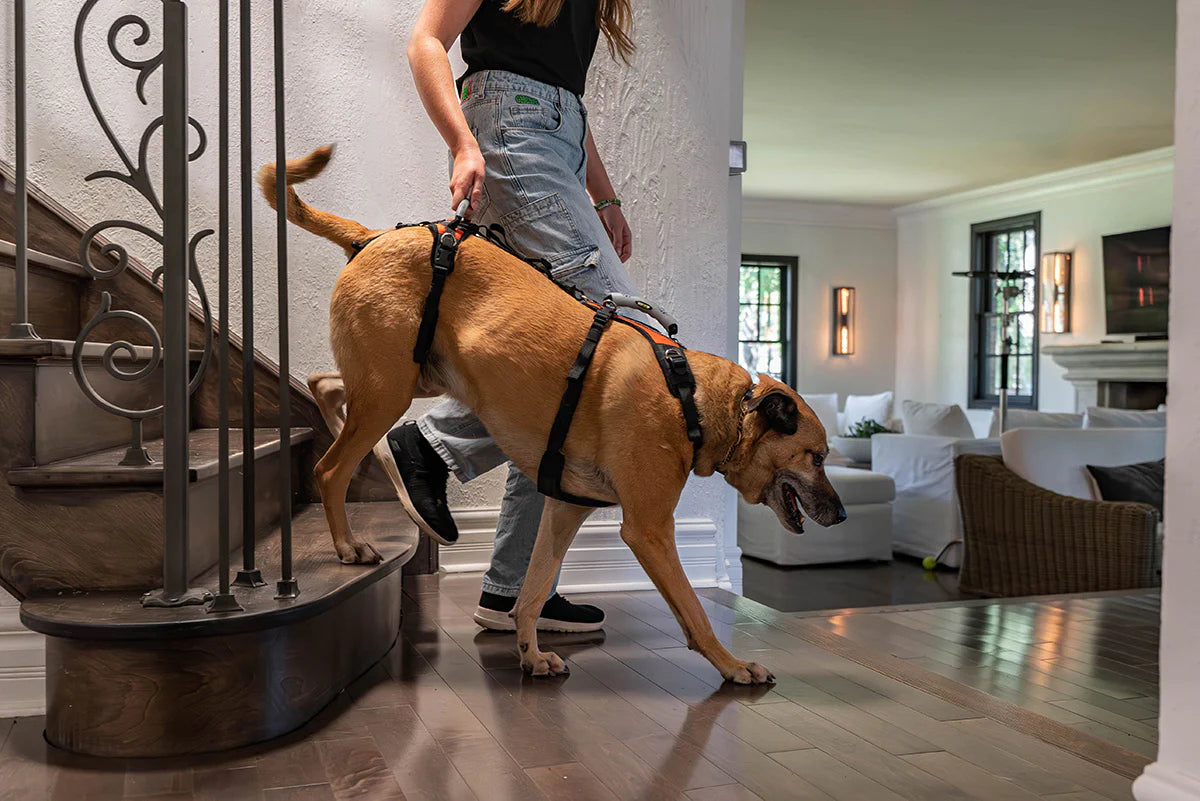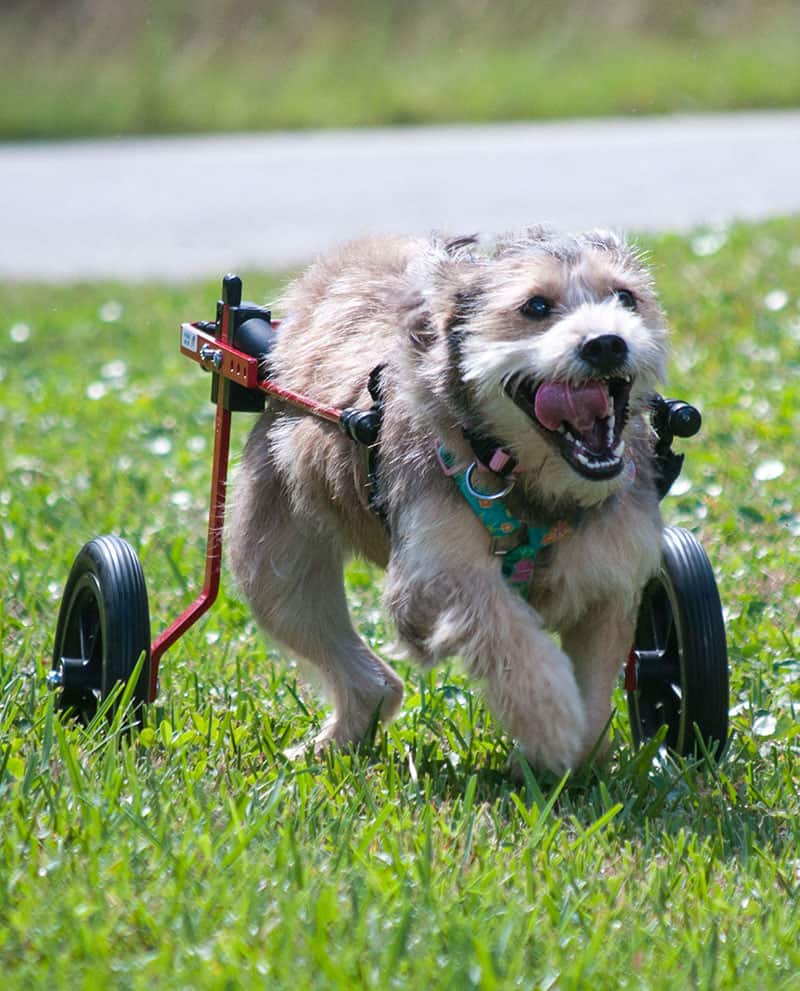Resources
Nursing Care
Nursing care for mobility impaired pets is an extremely important part of your day as we are well aware.Over the past 50 years we have gained a large knowledge base for the care of your pet and we are happy to help you in anyway possible.
Bladder Care & Urinary Health
Preventative bladder care plays a critical part in the health of your pet. If your pet has suffered nerve damage to the hindquarters, paralysis, or stroke, your pet’s bladder must be expressed at least three times daily. If you do not know how to do this, have your veterinarian show you. Mobility impaired pets are subject to “pooling” or partial urine retention. Often when you find your pets bed wet, it does not mean that it is urinating on its own, but that the bladder has become so full that there is an overflow.Due to nerve injury to the hindquarters, paralysis, or stroke, cystitis or bladder infection is one of the greatest threats to your pet’s health. Such infections are very serious and could lead to death in a matter of days if left untreated. This applies whether your pet is totally paralyzed, partially paralyzed, or walking.
Signs of a Urinary Tract Infection Include:
Dribbling or evidence of urine, such as soaking of the rear quarters and bedding.
Foul odor of urine, and an increased licking of the genital area as infections worsens.
Bloody or dark colored urine. This is a severe symptom and requires immediate veterinary care!
Depression, loss of appetite, rise in temperature as infection progresses.
Treatment of Urinary Tract Infection
Due to the insidious nature and frequency of this type of infection, prophylactic medical treatment, before signs of infection occur, offers the best solution. The cooperation of your veterinarian in prescribing the best medication, monitoring pH, culturing the urine, and providing instruction on expressing or clearing the bladder of pooled urine is essential for successful nursing care. Urine retained in the bladder can become a medium for bacterial growth.
Proper Bedding
Confining your pet to an area where there is plenty of soft bedding, when not in its cart or Protect-A-Pet, is important to keep your pet from dragging itself around as this will help prevent pressure sores. It is also crucial to your pet’s health and recovery. If given a choice, most pets will choose a hard, cool surface over a soft, padded area to rest on. This makes your handicapped pet more susceptible to developing Decubital, or pressure, sores. See our Canine Cooler pet bed; it provides a solution. It keeps your pet cool and helps to prevent pressure sores.
We have found the following guidelines to be helpful:
We recommend the Canine Cooler pet waterbed. This bed is ideal for pets that get hot easily and seek out a cold surface to lie on. Cool surfaces are often hard surfaces; and for a mobility impaired pet, lying on a hard surface makes it more susceptible to pressure sores and hygromas (elbows sores).
Do not allow your handicapped pet to lie continually on one side. Turn it over regularly. For pets with forelimb weakness, or rear limb problems, it is sometimes better to prop them up in sternal recumbency (on abdomen with front legs extended and hind legs tucked up underneath) using rolled up blankets on either side of their body with their head resting on a rolled up towel.
Do not allow your pet to drag around, unprotected, over any hard surface as this will cause pressure sores. Once established, these sores are difficult to heal.
Regular Bathing
Regular bathing will maintain your handicapped pet’s hair, coat and skin in healthy condition and prevent sores. Your pet’s hindquarters must be gently bathed, at least once daily, with warm water and a soft, clean washcloth. If your pet has an excessive amount of hair, you may want to clip the rear area for sanitary reasons, ease of care, and to keep the area clean.
Pressure Sores
Pressure sores can be extremely serious and, if not caught in time, can open right down to the bone. Prevention is the best answer. Proper bedding (see our Canine Cooler pet bed), regular bathing, and use of a K9 handicap pet wheelchair will also help prevent pressure sores.
Pets should be checked every day for pressure sores as they can be hidden underneath the hair; be particularly watchful with long-haired pets as the sores can be hidden in the coat. Check your pet’s hips and elbows for sores if it has a tendency to lie on one side. If your handicapped pet continually lies on its side, we suggest placing it in a sternal recumbency (on abdomen with the front legs extended and rear legs tucked underneath). You will also need to place a blanket on each side and one under the head to keep your handicapped pet propped up.
If your pet does incur pressure sores, visit your veterinarian immediately. Your veterinarian will probably clip and clean the area and advise you on proper care of pressure sores.
Rehabilitation & Physical Therapy
Rehabilitation
After an injury or surgery, we all know how important it is to get ourselves moving, as soon as possible, and to stay mobile. This helps to keep our limbs and joints flexible. Most of us also know that the more bed rest we get, the longer the pet rehabilitation process is going to take. Even after major surgery, patients are usually advised by their doctor to get out of bed and start walking. Doctors know that this will speed up the recovery process. Pet Physical therapy is often prescribed, and to assist walking at home, we may also be given crutches, a walker, or wheelchair. Patients are seldom prescribed bed rest for long periods of time.
When it comes to our pets, the same approach to pet rehab applies. After an illness or surgery, we need to get our pet moving as soon as possible. Herein lays the problem. How do we get our pet up and moving and still protect it from re-injuring or hurting itself? Most pets, if given the opportunity, will drag themselves around (and this is a risk for further injury) as they do not like being confined or kept away from the rest of the family.
Options
1. After back surgery cage rest is usually recommended for your pet by some pet hospitals and veterinarians to allow healing and prevent re-injury. For other surgeries, such as knee and hip, we recommend renting a wheelchair to aid in recovery.
However, we recommend supervised activity (see Option 3) in one of our carts, shortly after surgery, for the following reasons:
Keeps your pet active and protects your pet by keeping the back and limbs in alignment
Being mobile, and able to join family activities again, will make for a happier pet
Nursing care will be easier for you
Getting your pet up on all fours will help prevent sores and urinary tract infections
Using a cart stimulates return to mobility by supporting the back and allowing your pet to start moving its legs. Once your pet has the ability to stand, and support itself, then you can use the cart with the paws down in a walking position.
2. Another approach we often see pet hospitals and vets use is to give the pet five to ten days of cage rest and then let the pet get aroundas best it can. This usually means the pet drags itself around on the floor. The downside of this approach is when a pet drags itself, itplaces a lot of stress on the healthy limbs and is more susceptible to sores and infections.
3. From over 50 years of observing mobility-impaired pets, we know that pets benefit from walking. Just as we benefit from usingcrutches, it is important for your pet to have a means of moving around while at home. Our K9 pet wheelchairs not only protect yourpet from further injury, but also encourage rehabilitation. If your pet’s condition precludes a return to walking independently, thenthe cart will provide improved quality of life and make physical therapy easier.
If your pet has just undergone surgery, and is unable to walk, we recommend the following:
Consult with your veterinarian regarding a wheelchair for your pet
A short period of cage rest (3-5 days) to allow your pet to heal from its surgery (check with your veterinarian for recommendations on the length of cage rest for your pet)
If your pet’s prognosis is good and your pet is likely to recover full mobility within 2-3 weeks, renting a pet wheelchair will help aid the pet rehabilitation process
If your pet is not likely to recover full mobility, then purchasing one of our wheelchairs would be a more cost effective solution for your pet’s mobility
SummaryWith proper fit and balance, our pet wheelchairs protect your pet from injury and give your pet mobility. The K9 Cart keeps the spine and limbs in alignment, takes stress of the back and both front and rear limbs, and is a great aid in keeping your pet’s joints and limbs flexible. Keeping the joints and limbs flexible will give your pet every advantage for full recovery when it regains feeling and movement.
Physical Therapy
Pet Physical therapy, together with a pet wheelchair, and a good nursing care program is often instrumental in bringing a pet back to walking independently.The type and amount of therapy you are able to provide will depend on the size of your pet, what your pet will tolerate, and your available finances. While there are many excellent pet rehabilitation and therapy centers throughout the USA, Canada and abroad, these can be expensive.
We have found, after 50 years of working with mobility impaired pets, that there are few things to equal the therapeutic value of placing your pet in one of our pet wheelchairs. We recommend either renting, or purchasing, one of our K9 carts as soon as you see your pet experiencing any mobility problem. The wheelchair encourages your pet to return to walking independently. However, if your pet is unable to walk on its own, the cart will give your pet a greatly improved quality of life and make Nursing Care easier for you. Please see our comments on Rehabilitation.
While there are many different types of physical therapy, most pet physical therapy programs usually include the following:
SwimmingSwimming is an excellent form of physical therapy! If you have a pool, take your pet in the pool with you. Life jackets are available from many pet and marine stores, if you would like one for your pet. Check out local vetinary pet rehabilitation centers for swimming facilities.
Flotation BathsFor smaller pets, that are not afraid of water, fill your bathtub with warm water that is deep enough to keep your pet’s paws off the bottom of the tub. Support your pet and allow it to swim with the front legs, while you move the rear legs, manually, back and forth.
For larger dogs, use a swimming pool if you have access to one. We remember once watching a Golden Retriever, who was totally paralyzed in the rear limbs and weak in the front, swim and retrieve a log out of the water. It was an amazing sight and a powerful demonstration of how buoyant and mobile we are in water versus the physical limitations we have on solid ground!
Range of Motion ExercisesIt is important for your pet to retain normal range of motion in its immobile limbs. This prevents joints from becoming rigid, immovable, or frozen. If we keep the joints and limbs flexible, when a pet does regain feeling and movement, it will have every advantage for full recovery.
When doing range of motion exercises, place the pet on its side with the paw flat on your hand. Move the leg up and down towards the hip; you may want to keep one hand on the knee of a larger pet or on the hip of a smaller pet. Turn the pet over and repeat. Although your pet may have no feeling in its legs, doing this daily will help keep the limbs and joints flexible. Wheely Willy is a great example of the positive results of performing range of motion exercises and the benefits of our pet wheelchairs. He is a 20-year-old Chihuahua and has been in a K9 Carts for 17 years. His owner, Deborah Turner, has done range of motion exercises regularly with Willy over the years. When not in a cart his legs are totally lifeless, yet while in his cart his little legs move like pistons! Deborah is often asked if he really is paralyzed and will even sometimes take him out of his cart to prove the point.
General Care
Never allow your pet to scoot around on its bottom with rear legs out at a 45-degree angle. This could cause limb deformity or damage to rear limbs and joints.
The length of time spent in the cart depends on your pet’s physical condition. We recommend little and often.
If your pet is paralyzed and weighs 40 pounds or less, we recommend using our Protect-A-Pet when not in the cart.
Rear Limb Amputees
Pets who have lost one rear limb generally manage to do very well for many years. They basically center their remaining leg under their rear and hop or run along well, However as they get older and that remaining limb gets out of alignment with the added stress of only having one leg to balance on, they will need help.
Will a K9 cart help them? The answer is yes! A K9 Cart will allow your pet to still use its remaining leg, while taking the added stress off the limb. Usually when a pet has a limb amputated, it is taken off high and there is just a stump remaining. A different support system is therefore needed to keep your pet balanced in its cart. We place padding over the ring where the leg is missing. You will probably have to put in extra padding, such as foam or folded up flannel to help prop up the rear so that your pet is balanced and not leaning to one side. Padding may even have to be placed alongside the good leg, as if it leans too much to that side the leg will be at an angle instead of straight down in the ring. We want your pet to be balanced in the cart and in alignment as this will prolong its active life.
There are adjustments that you pet will have to make in the cart, as probably for years they have been going down on their one leg and springing forward. Now with correct support in our dog wheelchair, they have to learn to walk again on all fours with their spine in a level position. When you assemble your K9 Cart, you may have to set the height lower than it will end up being so that your pet can gradually become used to a new way of walking.
We at K9 Carts are always here to help you with advice and help with the fitting of your cart once you receive it.









